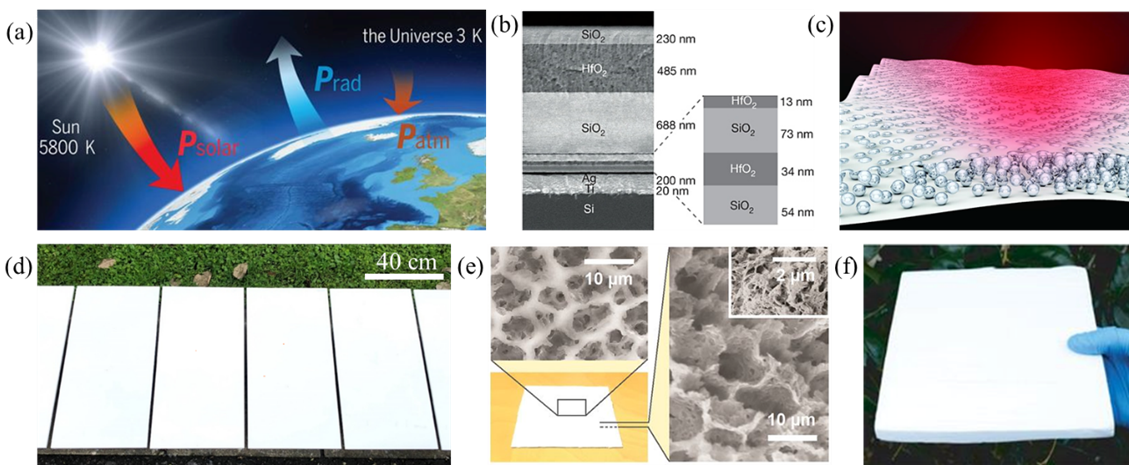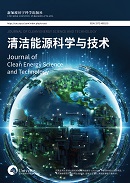辐射制冷材料的发展与进步
DOI:
https://doi.org/10.18686/cncest.v2i1.128摘要
工业时代以来,化石能源的大量使用导致温室气体的排放量不断增加,进而加速全球变暖。制冷能耗是能源消耗的重要组成部分,约占全球总能源消耗的20%,因此迫切需要发展低能耗、高效且环保的新型制冷技术以满足不断增长的制冷需求。辐射制冷因其零能耗制冷特性受到国内外学者的广泛关注,它的基本原理是地表物体通过大气层在“大气窗口”(8–13 μm)波段的高透过特性,将自身废热以热辐射的形式散失至低温太空,从而获得被动降温和制冷效果。早期阶段,辐射制冷的研究和探索局限于夜间工况,因此辐射制冷材料的核心在于红外发射率的优化与调控。相比于单纯的夜间辐射制冷,日间辐射制冷还可以在太阳辐射条件下实现被动降温与制冷,因此更具应用价值。

##submission.downloads##
已出版
文章引用
期
栏目
执照
版权声明
##submission.license.cc.by4.footer##参考
1. Wu C. Rapid rising in radiative forcing. Clean Energy Science and Technology. 2024; 2(1). doi: 10.18686/cest.v2i1.110
2. Yin X, Yang R, Tan G, et al. Terrestrial radiative cooling: Using the cold universe as a renewable and sustainable energy source. Science. 2020; 370(6518): 786-791. doi: 10.1126/science.abb0971
3. Zhao B, Hu M, Ao X, et al. Radiative cooling: A review of fundamentals, materials, applications, and prospects. Applied Energy. 2019; 236: 489-513. doi: 10.1016/j.apenergy.2018.12.018
4. Cui Y, Luo X, Zhang F, et al. Progress of passive daytime radiative cooling technologies towards commercial applications. Particuology. 2022; 67: 57-67. doi: 10.1016/j.partic.2021.10.004
5. Orel B, Gunde MK, Krainer A. Radiative cooling efficiency of white pigmented paints. Solar Energy 1993; 50: 477-482. doi: 10.1016/0038-092X(93)90108-Z
6. Baranov DG, Xiao Y, Nechepurenko IA, et al. Nanophotonic engineering of far-field thermal emitters. Nature Materials. 2019; 18(9): 920-930. doi: 10.1038/s41563-019-0363-y
7. Zhang J, Shi K, Lu L, et al. Experiments on near-field radiative heat transfer: A review. Clean Energy Science and Technology. 2023; 1(1). doi: 10.18686/cest.v1i1.45
8. Raman AP, Anoma MA, Zhu L, et al. Passive radiative cooling below ambient air temperature under direct sunlight. Nature. 2014; 515(7528): 540-544. doi: 10.1038/nature13883
9. Zhai Y, Ma Y, David SN, et al. Scalable-manufactured randomized glass-polymer hybrid metamaterial for daytime radiative cooling. Science. 2017; 355(6329): 1062-1066. doi: 10.1126/science.aai7899
10. Song J, Zhang W, Sun Z, et al. Durable radiative cooling against environmental aging. Nature Communications. 2022; 13(1). doi: 10.1038/s41467-022-32409-7
11. Mandal J, Fu Y, Overvig AC, et al. Hierarchically porous polymer coatings for highly efficient passive daytime radiative cooling. Science. 2018; 362(6412): 315-319. doi: 10.1126/science.aat9513
12. Li T, Zhai Y, He S, et al. A radiative cooling structural material. Science. 2019; 364(6442): 760-763. doi: 10.1126/science.aau9101
13. Yang W, Zhang E, Zhao J, et al. Dawn of clean energy: Enhanced heat transfer, radiative cooling, and firecracker-style controlled nuclear fusion power generation system. Clean Energy Science and Technology. 2023; 1(1). doi: 10.18686/cest.v1i1.61
14. Meng X, Chen Z, Qian C, et al. Durable and mechanically robust superhydrophobic radiative cooling coating. Chemical Engineering Journal. 2023; 478: 147341. doi: 10.1016/j.cej.2023.147341
15. Chen Y, Mandal J, Li W, et al. Colored and paintable bilayer coatings with high solar-infrared reflectance for efficient cooling. Science Advances. 2020; 6(17). doi: 10.1126/sciadv.aaz5413
16. Li W, Shi Y, Chen Z, et al. Photonic thermal management of coloured objects. Nature Communications. 2018; 9(1). doi: 10.1038/s41467-018-06535-0
17. Lin K, Chen S, Zeng Y, et al. Hierarchically structured passive radiative cooling ceramic with high solar reflectivity. Science. 2023; 382(6671): 691-697. doi: 10.1126/science.adi4725
18. Zhao X, Li T, Xie H, et al. A solution-processed radiative cooling glass. Science. 2023; 382(6671): 684-691. doi: 10.1126/science.adi2224
19. Zhao D, Tang H. Staying stably cool in the sunlight. Science. 2023; 382(6671): 644-645. doi: 10.1126/science.adk9614




